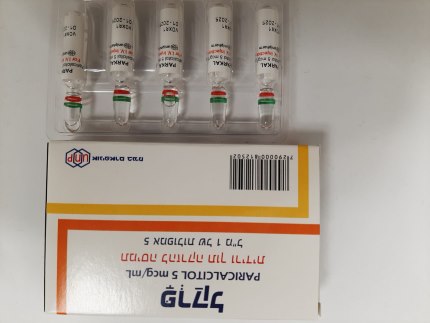Quest for the right Drug

פרקל PARKAL (PARICALCITOL)
תרופה במרשם
תרופה בסל
נרקוטיקה
ציטוטוקסיקה
צורת מתן:
תוך-ורידי : I.V
צורת מינון:
תמיסה להזרקה : SOLUTION FOR INJECTION
עלון לרופא
מינוניםPosology התוויות
Indications תופעות לוואי
Adverse reactions התוויות נגד
Contraindications אינטראקציות
Interactions מינון יתר
Overdose הריון/הנקה
Pregnancy & Lactation אוכלוסיות מיוחדות
Special populations תכונות פרמקולוגיות
Pharmacological properties מידע רוקחי
Pharmaceutical particulars אזהרת שימוש
Special Warning עלון לרופא
Physicians Leaflet
Pharmacological properties : תכונות פרמקולוגיות
Pharmacodynamic Properties
5.1 Pharmacodynamic properties Pharmaco-therapeutic group: Anti-parathyroid agents, ATC code: H05BX02. Mechanism of action: Paricalcitol is a synthetic, biologically active vitamin D analog of calcitriol with modifications to the side chain (D2) and the A (19-nor) ring. Unlike calcitriol, paricalcitol is a selective vitamin D receptor (VDR) activator. Paricalcitol selectively upregulates the VDR in the parathyroid glands without increasing VDR in the intestine and is less active on bone resorption. Paricalcitol also upregulates the calcium sensing receptor (CaSR) in the parathyroid glands. As a result, paricalcitol reduces parathyroid hormone (PTH) levels by inhibiting parathyroid proliferation and decreasing PTH synthesis and secretion, with minimal impact on calcium and phosphorus levels, and can act directly on bone cells to maintain bone volume and improve mineralization surfaces. Correcting abnormal PTH levels, with normalization of calcium and phosphorus homeostasis, may prevent or treat the metabolic bone disease associated with chronic kidney disease.
Pharmacokinetic Properties
5.2 Pharmacokinetic properties Distribution The pharmacokinetics of paricalcitol have been studied in patients with chronic renal failure (CRF) requiring haemodialysis. Paricalcitol is administered as an intravenous bolus injection. Within two hours after administering doses ranging from 0.04 to 0.24 microgram/kg, concentrations of paricalcitol decreased rapidly; thereafter, concentrations of paricalcitol declined log-linearly with a mean half-life of about 15 hours. No accumulation of paricalcitol was observed with multiple dosing. In vitro plasma protein binding of paricalcitol was extensive (>99.9%) and nonsaturable over the concentration range of 1 to 100 ng/mL. Biotransformation Several unknown metabolites were detected in both the urine and faeces, with no detectable paricalcitol in the urine. These metabolites have not been characterised and have not been identified. Together, these metabolites contributed 51% of the urinary radioactivity and 59% of the faecal radioactivity. Paricalcitol Pharmacokinetic Characteristics in CRF Patients (0.24 μg/kg dose) Parameter N Values (Mean ± SD) Cmax (5 minutes after bolus) 6 1850± 664 (pg/mL) AUC0-∞ 5 27382 ± 8230 (pg•h/mL) CL 5 0.72 ± 0.24 (L/h) Vss 5 6 ± 2 (L) Elimination In healthy subjects, a study was conducted with a single 0.16 microgram/kg intravenous bolus dose 3 of H-paricalcitol (n=4), plasma radioactivity was attributed to parent substance. Paricalcitol was eliminated primarily by hepatobiliary excretion, as 74% of the radioactive dose was recovered in faeces and only 16% was found in urine. Special Populations Gender, Race and Age No age or gender-related pharmacokinetic differences have been observed in adult patients studied. Pharmacokinetic differences due to race have not been identified. Hepatic impairment Unbound concentrations of paricalcitol in patients with mild to moderate hepatic impairment are similar to healthy subjects and dose adjustment is not necessary in this patient population. There is no experience in patients with severe hepatic impairment.

שימוש לפי פנקס קופ''ח כללית 1994
לא צוין
תאריך הכללה מקורי בסל
לא צוין
הגבלות
לא צוין
מידע נוסף
